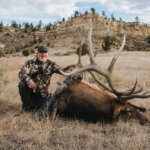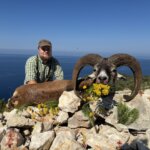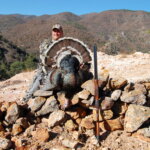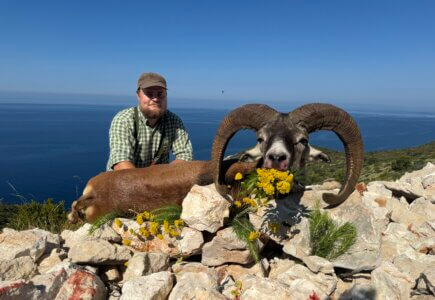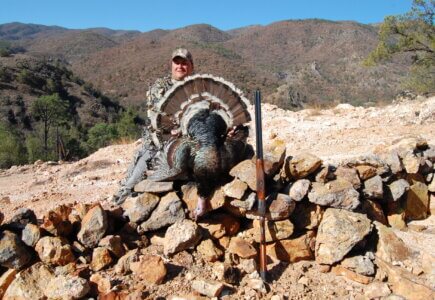I’ve lost count of the times I’ve heard, “you’ve got the greatest job in the world!” Being a professional hunting consultant, I believe that may very well be true.
WTA consultants are fortunate to be able to travel the world and explore new and exciting destinations but we don’t have a blank check and don’t always get to choose where we go. I know. That probably doesn’t sound like much a hardship, but bear with me.
Truthfully, my destination this spring was not one I would have chosen. My personal interest level wouldn’t have put me in the jungle in southern Mexico, just 20 miles off the Guatemala border, chasing ocellated turkeys and brocket deer, but what an experience it turned out to be. I’m so glad I was given the opportunity!

The trip started in the historic coastal city of Campeche. On the evening we arrived, we enjoyed great dining at a local restaurant and capped off the night with a walk along the boardwalk overlooking the Gulf of Mexico where the city puts on a spectacular water show each evening at 8 p.m. After a good night’s sleep, we jumped in a van and headed to the small town of Constitution about two hours away. In Constitution, we transferred to Jeeps and started the long, rough three-hour trip into the jungle. I have to say, one thing that interested me from the start was simply getting to see the ecosystem of the jungle up close. It didn’t disappoint! With sore butts, we arrived at camp, got settled in, met our guides, was briefed on what to expect in the coming days and before we knew it, we were back in the Jeeps headed out for an evening hunt.
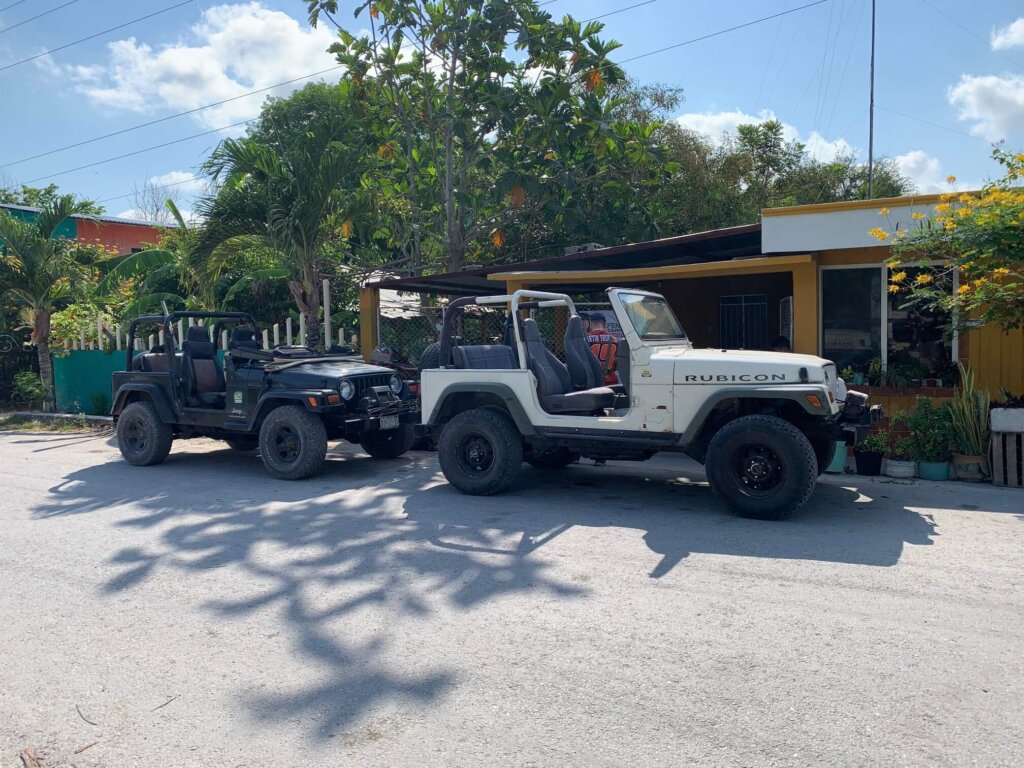
Many times when we write about a destination or experience, we talk about the wildlife and how plentiful, unique or interesting it is and that seems to be the focal point of the story. Well, let me tell you, there’s lots of wildlife in the jungle, all kinds of species and it’s all very cool, extremely unique and there is no way I am able to give it the credit deserved simply because words can’t truly describe the sounds and colors each of the many animals has. You need see it to really grasp the greatness of all.
So, I’ll expand on the people you hunt with here because they are the ones who make this such a great experience. I consider myself a pretty solid woodsman and hunter. I believe I can get it done pretty much anywhere on the planet once I figure out the terrain simply because animal movement and tendencies are relatively universal and if you pay attention to details and look for similarities you have a good chance for success. I’ve picked up bits and pieces of how to do this from experienced experts, from fly-fishing guides in Alaska who can read water at a glance to an African tracker who can distinguish one lone dugga boy track on a well-traveled game trail. I’ve spent time with some of the best over the past 25 years.
I mention that just to emphasize this. These guides in the jungle are by far the best I’ve ever shared the field with! These men grew up in this jungle and their ability to see, hear, read and find signs of game is unbelievable. There wasn’t a day when returning to camp after a hunt I didn’t have a unique story to share with the other hunters and they were all having the same type of experience. I was fortunate to harvest my ocellated turkey early in the hunt and changed my focus to brocket deer after a little coaxing by Sergio, who assured me chasing these little ghosts of the jungle is pretty cool. Being a diehard bowhunter who loves to chase big whitetails in Canada and throughout the Midwest, I wasn’t all that excited about chasing a 40-pound deer with spikes on its head – and the difference between an average brocket and a world-class brocket is about the width of your thumb, but let’s give it a go!
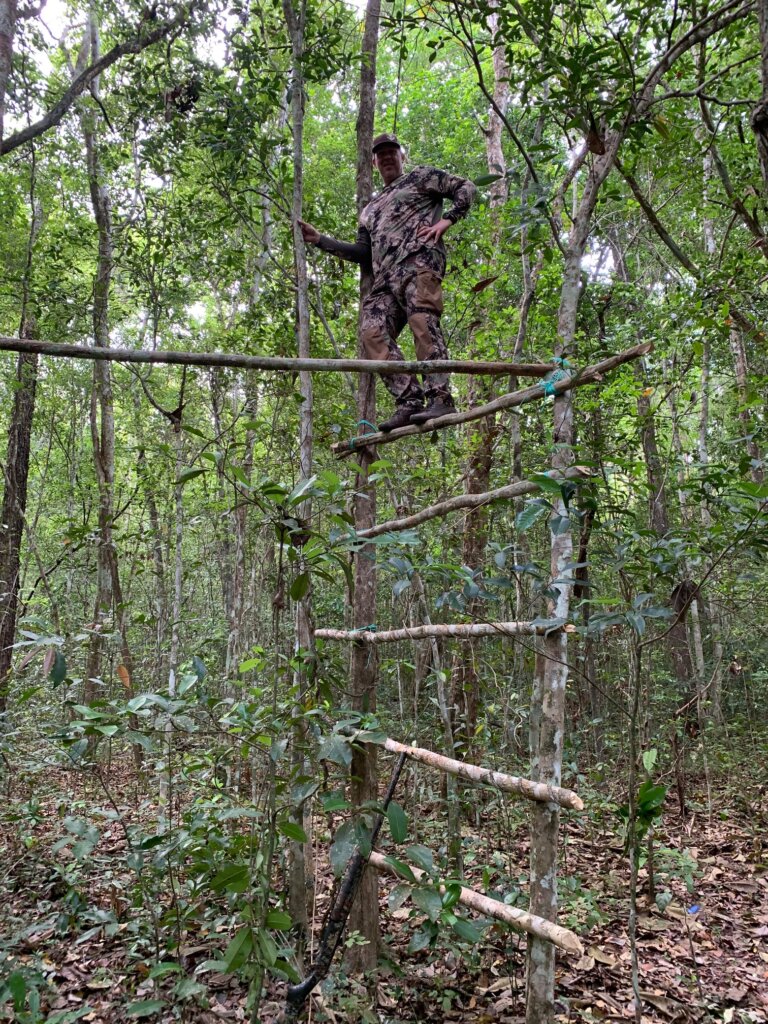
Each jungle guide is responsible for having his own brocket deer spots scouted in case their clients want to hunt them. They hold these places close to their chest because getting their client a brocket deer is a way of earning “street cred” among the other guides. Once my guide heard I was switching to brocket deer, he was excited. He had two options for us, we could either sit near a waterhole in the middle of the jungle or he had found a scrape line, which is where he wanted to start. We took off into the middle of the jungle and ended up on a line of scrapes each about the size of a coffee can lid. He had constructed their version of a treestand overlooking this scrape line with a series of four-inch logs nailed to the tree to act as a ladder and doubled it up at the top for a footrest. Above the footrest, he hung a hammock for me to sit in; they call this a “machan.”
Being a bigger guy, I had a little trepidation climbing up there, but I must say it was comfortable and once settled in, I felt very safe. You sit in the hammock, not lay down. I tried laying for the first couple hours and it took roughly three minutes before I was asleep. When I woke, my guide explained, through rough translation, that I needed to sit with my feet on the top double rung of the ladder and stay alert because this can happen fast.
While scanning the jungle floor, I was trying to figure out a couple things. First, how in the hell did he find this scrape line? I mean this cover is thick and there are no edges at all, which is commonly where deer in the Lower 48 make scrapes. There was no transition from one style of cover, shrubbery or grass to another and everything looked exactly the same the entire walk in and I’m guessing for the next few miles if we had kept walking. It seemed so random. Second, how am I going to get off a shot at an oversized woodchuck-sized deer in this thick cover?
We hunted the entire first afternoon from the stand with no sightings, but my intrigue and anticipation was building by the minute and I wanted to make sure my guide knew I wanted to see this through, so whatever he wanted to do, I was brocket deer hunting for the remainder of my stay in the jungle. I was all in on this! He said we needed to stick it out for a few days on the scrape line because (and this is something I learned) brocket deer are very religious about checking their scrapes and if we would put in our time, we would have a great chance of seeing the buck making these markings.
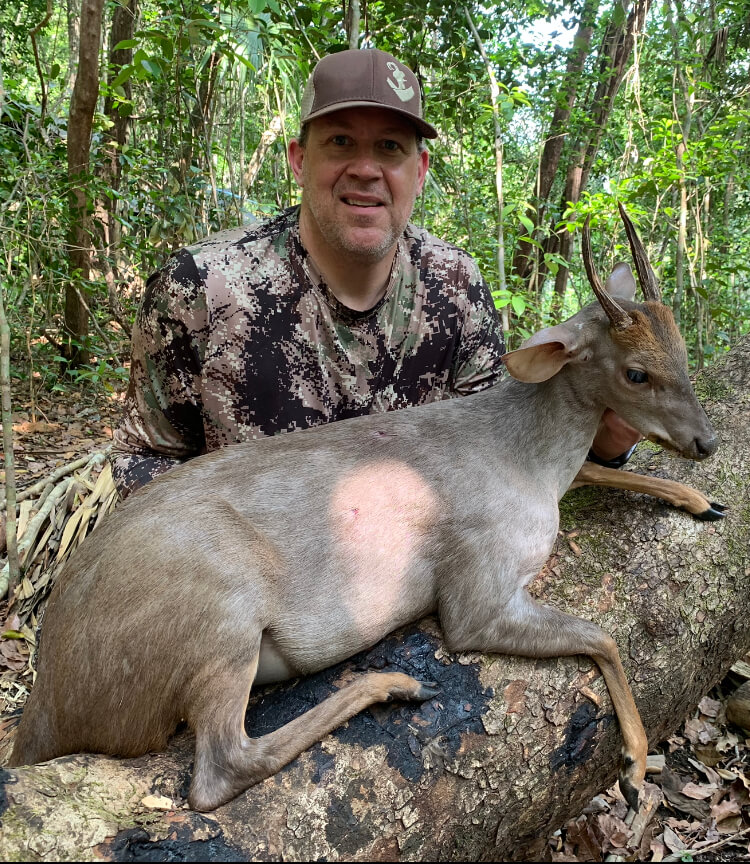
The following day we hunted until late morning and returned for an evening sit, all with no sightings. The next morning we got in early, settled in and were greeted with the wonderful sounds of the jungle coming alive with the rising sun. The howler monkeys in the distance sounded really pissed about something and kept my attention until mid-morning. It was roughly 11 a.m. and I could tell my guide was starting to think about heading out when we both caught movement 30 yards to our left. It was the flicker of a brocket tail. His eyes lit up, he pointed and said, “Brocket.” I couldn’t make out the body and it was gone. In what seemed like five minutes but was actually about 20 seconds I caught a glimpse of a front shoulder moving from left to right through the choked jungle floor, pulled up and let it fly! Before my empty cartridge hit the ground, my guide jumped 10 feet from our stand and took off running in the direction of the shot. I could see the brush moving and he charged in like a pitbull. Before I even realized what had happened, he came out smiling ear to ear with pure excitement, with my brocket by its ankles.
I could tell this meant as much to him as it did to me and together we had really accomplished something because we had harvested an exceptional buck. He kept saying “grande, grande!” I didn’t know it then, but three-inch spikes on a brocket is a good mature animal and the one we had just harvested was just under five inches. Big, small, size or score have never meant much to me. The coolest part about animals and hunting them is where they live and the people you get to meet and share these experiences with along the way.
This adventure was truly one I will never forget; the things I learned, people I met and shared this with and the environment – all outstanding. Believe me. Any skepticism I had about this hunt is gone and I’m almost ashamed of my initial reluctance. What an experience I would have missed and a special place I would have never seen and extraordinary hunters I would not have met.
What I learned from all this – and it’s my advice to you – if you have an opportunity before you, grab it with both hands.
As for the jungle, I will return.

